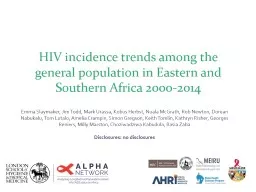

20052016 Emma Slaymaker Jim Todd Mark Urassa Kobus Herbst Nuala McGrath Rob Newton Dorean Nabukalu Tom Lutalo Amelia Crampin Simon Gregson Keith Tomlin Kathryn ID: 812282
Download The PPT/PDF document "HIV incidence trends among the general p..." is the property of its rightful owner. Permission is granted to download and print the materials on this web site for personal, non-commercial use only, and to display it on your personal computer provided you do not modify the materials and that you retain all copyright notices contained in the materials. By downloading content from our website, you accept the terms of this agreement.
Slide1
HIV incidence trends among the general population in Eastern and Southern Africa 2005-2016
Emma Slaymaker, Jim Todd, Mark Urassa, Kobus Herbst, Nuala McGrath, Rob Newton, Dorean Nabukalu, Tom Lutalo, Amelia Crampin, Simon Gregson, Keith Tomlin, Kathryn Risher, Georges Reniers, Milly Marston, Choziwadziwa Kabudula, Basia ZabaDisclosures: no disclosures
Slide2The ALPHA Network
Network for Analysing Longitudinal Population-based HIV/AIDS data on AfricaKenyaKisumu: CDC/KEMRI (Gem) Nairobi: APHRCUgandaRakai: Rakai Community Cohort studyMasaka: Kyamulibwa GPCTanzania
Kisesa:
Kisesa Cohort study
Ifakara
:
Ifakara urban DSS
MalawiKaronga
: Karonga
DSS
ZimbabweManicaland
:
Manicaland
GPC
South Africa
Agincourt: Agincourt HDSSuMkhanyakude: Population Intervention Platform, AHRI
GPC: General Population Cohort(H)DSS: (Health and) Demographic Surveillance Study
Slide3Analysis objectives3 studies have recently described incidence declinesAims:
Describe changes over time:For six studiesFor men and womenUsing pooled data from all studiesEvaluate the role of:TreatmentMale circumcisionChanges in participationEthics approval from LSHTMFunding from Bill and Melinda Gates Foundation
Slide4Methods for incidence analysis (1) HIV tests conducted at regular intervals on all residents (1- 3 years apart)
Observation starts at first HIV negative test recorded while resident in study areaParticipants were followed until study exit or testing HIV positive.Study exit was at: out-migration from study areadeathadministrative censoring at most recent study round (last HIV test)
Slide5Methods for incidence analysis (2) Seroconversion date imputed between last negative and first positive date. We:
ran 70 imputationsused a uniform distribution for seroconversion datesused all seroconversion intervals, regardless of lengthExcluded gaps in residency from denominator, excluded non-resident seroconversions and discarded subsequent negative person time
Slide6Covariates for incidence analysis: 1) HIV and treatment status among potential partners
Estimation of person-time spent untreatedlinked clinical records and self-report used to identify PLHIV receiving treatmentPLHIV person-time classified as untreated prior to date of ART initiation or first observed treatment episode (doi: 10.12688/gatesopenres.12753.1) Estimation of HIV prevalence in potential sexual partnersreported ages of sexual partners used to define age-mixing matrixHIV prevalence estimated for men and women in each cell of the matrixEstimation of untreated HIV prevalence in potential opposite sex partnersHIV prevalence combined with proportion untreated to estimate untreated prevalenceEach individual assigned the untreated prevalence estimate for the opposite sex in the age range of potential sexual partners.Do not know: the HIV status of sexual partnersCan estimate: the HIV prevalence and treatment coverage in the group of people who are potential sexual partners.
Slide7Covariates for incidence analysis: 2) circumcision and 3) participation
Estimation of circumcision status:Male circumcision was self reported during surveysCircumcision status of individuals at survey assigned based on self-report and carried forwards until any subsequent survey Estimation of participation levels:Survival analysis of time from a study HIV test to the next study HIV testFor each survey round, estimated the percentage of people who had previously tested negative and were still eligible for the survey who were successfully tested for HIV.Untreated prevalence, circumcision status (men only) and participation probability all explored as time-varying covariates
Slide8Incidence cohort sizes- 2005 onwards
Study name & years data are available SexNumber of peopleNumber of person yearsNumber of seroconversionsKarongaMen4,57410,95130(2006-2012)Women5,81314,35659
Kisesa
Men
3243
15,060
82
(2005-2015)Women
4284
21,530
155
Manicaland
Men
4,479
16,627
150
(2005-2013)
Women 6,512 25,462305 MasakaMen 4,881 21,04985(2005-2016)Women
5,994 25,873139 RakaiMen 7,126 30,491234(2005-2016)Women 8,352 38,136354 uMkhanyakudeMen
8,670
32,613
712
(2005-2017)
Slide9Crude Incidence trends by study- men 15-49
Slide10Crude Incidence trends by study- women 15-49
Slide11Trends among 15-24 and 25-49 year olds
Slide12Trends among 15-24 and 25-49 year olds
Slide13Pooled age-stratified analysis of trends: men
p<0.1; ** p<0.05; *** p<0.01Incidence rate ratios (IRR) for calendar time from piecewise exponential survival models†Adjusted models include calendar year group, study, circumcision, untreated prevalence in the opposite sex and probability of retesting.
Slide14Pooled age-stratified analysis of trends: women†Adjusted models: calendar year group, study, , untreated prevalence in the opposite sex and probability of retesting.
Incidence rate ratios (IRR) for calendar time from piecewise exponential survival models p<0.1; ** p<0.05; *** p<0.01
Slide15ConclusionMale incidence has declined No evidence for female incidence decline apart from Rakai and ManicalandWhere declines are seen:
Among young people decline can be explained by change in the prevalence of infectious opposite sex partners.Among older people change over time not entirely explained by changes in untreated prevalence, circumcision or participation-Epidemic dynamics and heterogeneity?Behaviour change?Untreated prevalence measure performs poorly for older people
Slide16In memory of Basia Zaba (1949-2018)